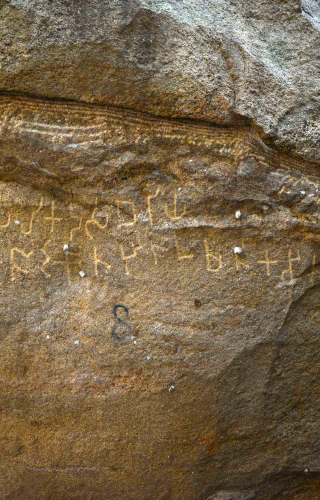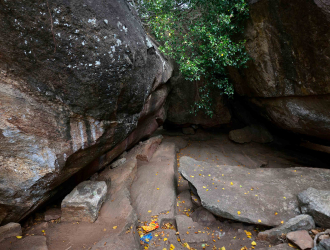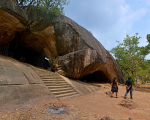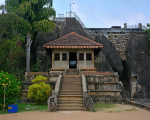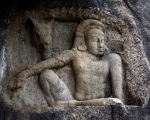Anuradhapura dominated Sri Lanka's early history and served as the capital city of the island nation for over a millennium. It was invaded and destroyed by Rajendra Chola I, one of the great kings of the powerful Chola dynasty of southern India. The last king of Anuradhapura, Mahinda V (r. 982–1017 CE), along with his family, was captured by the Cholas and taken prisoner to India, where he died in 1029 CE.
Like its downfall, Anuradhapura’s establishment was also linked with events originating in India. The settlement was founded by Anuradha, who worked as a minister in the court of Prince Vijaya (543–505 BCE), the first king of Sri Lanka and ancestor of the Sinhalese people, who had migrated from Kalinga (present-day Odisha, India) with 700 followers. The settlement was initially named Anuradhagama and rose to political prominence when King Pandukabhaya (474–367 BCE) established his capital there in 377 BCE. Anuradhagama finds mention in Ptolemy’s Geographia, written around 150 CE, as Anurogramma. The city expanded greatly under the patronage of successive ruling dynasties to become the epicentre of the Kingdom of Anuradhapura. The kingdom’s political authority gradually extended over whole of Sri Lanka, and the city remained the seat for all rulers from 377 BC to 1017 CE. The only break in this 1394-year sequence was by King Kashyapa I, who, in 473 CE, shifted his capital to the rock-citadel at Sigiriya, but reverted to Anuradhapura in 491 CE.
Even as the Kingdom of Anuradhapura established its political writ on Sri Lanka, events happening in India continued to have profound influence on the course of its affairs. From Magadha in eastern India, Emperor Ashoka’s campaign aimed at the expansion of the Mauryan Empire resulted in the bloody Kalinga War (ended c. 265 BCE). Moved by the horrors of the war, Ashoka became a devout Buddhist and patronised the spread of Buddhism throughout India, announcing precepts of Dharma through edicts, building stupas to house Buddha’s relics and erecting stone pillars to mark Dharmachakra parivartana (turning of the Wheel of Law). He also sponsored diplomatic missions for preaching Buddhism in foreign lands.
On one such mission Ashoka sent his son, Prince Mahendra, to Sri Lanka. Mahendra was received with great reverence by King Devanampiya Tissa (r. 307–267 BCE), and he converted to Buddhism at Mihintale. To mark the event, the Thuparamaya was constructed at Anuradhapura which contained the relic of Buddha’s right collar bone. Encouraged by the success of the first mission, Ashoka sent a follow-up mission to Sri Lanka, this time a group of bhikkhunis (nuns) led by his daughter, Princess Sanghamitra, in order to propagate Dharma amongst the royal ladies of the court at Anuradhapura. She also brought a gift of a sapling from the Bodhi tree (under which Buddha attained enlightenment at Bodhgaya), to be installed at Anuradhapura. Sanghamitra would live the rest of her life in Anuradhapura till her death at age 79. Her brother Mahendra died at Mihintale, both during the rule of Devanampiya Tissa’s successor King Uttiya (r. 267–257 BC). These events marked the arrival and establishment of Buddhism in Sri Lanka and, since then, Buddhism has shaped not only the religion, society and culture of the Sinhalese people, but also the administration, diplomatic relations, legal system and nature of kingship in Sri Lanka. One of the most important rajdharma (royal duty) of the sovereign was to maintain harmony of the Buddhist Sangha and establish Buddha-sasana (Buddha’s dispensation) in Sri Lanka.
The next event that impacted Anuradhapura was the arrival of the Tooth of Buddha, which was smuggled out of Kalinga by Princess Hemamala, who hid the relic in her hair. Kalinga, therefore, appears time and again in the history of Sri Lanka. Hemamala handed over the relic to King Kithsirimevan (r. 301–328 CE), who commissioned the Abhayagiri Dagoba (Stupa) to enshrine the sacred tooth. King Kithsirimevan also started the practice of Dalada Perahara, the procession where the sacred tooth is paraded for veneration of the common people, an annual ritual which continues to this day in Kandy. Since then the sacred relic has remained in Sri Lanka. This was the reason the royal palace and the ‘temple of the tooth’ formed an integrated common source of authority; one spiritual and one political.
Abhayagiri Dagoba was not only one of the largest man-made structures in the ancient world, but it was also a famous mahavihara (residential university), attracting scholars from around the world and having links to other mahaviharas in India, like Nalanda and Somapura. This resulted in students moving from one university to another, gaining professional qualifications, learning from famous teachers, collecting rare Buddhists texts and carrying them to other countries for translation. The strategic location of Anuradhapura made it an important port-of-call for scholars travelling between India, Southeast Asia and China. Less than a century after the arrival of the sacred relic, the Chinese scholar and monk Faxian visited Anuradhapura in 410 CE. He lived for two years at Abhayagiri mahavihara, and recorded his experience of witnessing the Dalada Perahara.
Other notable itinerants who visited Anuradhapura includes Vajrayana scholar Vajrabodhi (671–741 CE; hailing from southern India and a graduate from Nalanda mahavihara) who stayed at the mahavihara for 6 months on his way to Srivijaya (in Palembang, Indonesia) from where he reached Chang’an (present- day Xi’an) in China. In 741 CE, Vajrabodhi’s disciple Amoghavajra (born in Samarkand to an Indian father) travelled to Abhayagiri with his disciples on the order of the then Chinese emperor Xuanzong of Tang (not the famous monk). He collected more than 500 tantric texts and returned to China in 747 CE. Another well-travelled Buddhist scholar who visited Abhayagiri was Gunavarman, born a prince in Kashmir, who renounced his royal inheritance and travelled to Sri Lanka. Gunavarman later visited Java and successfully converted the queen-mother and king to Buddhism. From Java he reached Nanjing, the capital of the southern Song dynasty in China in 431 CE. Such long journeys were undertaken not only by male monks, but by bhikkhunis as well, so they could deliver the Upasampada (ritual of ascetic ordination) to novice bhikkhunis in China. In 426 CE, Gunavarman sent 8 Sinhalese bhikkhunis to Nanjing, followed by another 10 Sinhalese bhikkhunis who ordained 3,000 Chinese bhikkhunis, 434 CE.
The prestigious place of Anuradhapura in Buddhist diaspora was mainly due to the acquisition of sacred relics linked to the Buddha. Many structures were specifically commissioned to house new relics, and their consecration celebrated by mega-congregation events. Invitations were sent to important Buddhist delegates well in advance, allowing them to plan their travel from far-off lands. In one such instance, according to the Mahavamsa (epic poem written in Pali language) records in 140 BCE, King Dutugemunu commissioned the Ruwanwelisaya Dagoba as a relic chamber for the original begging bowl of Buddha. This was a major event in the Buddhist world at the time, and the Mahavamsa gives us a list of delegations from various parts of India, as well as a large delegation of 30,000 monks who arrived from Alexandria-of-the-Caucasus (modern-day Bagram in Afghanistan) led by the Indo-Greek master Mahadharmarakshita. Such long-distance trans-oceanic voyages were possible due to the existence of a robust maritime network of ports and well-established trading routes in the Indian Ocean, Bay of Bengal, Arabian Sea and South China Sea. Buddhist scholars, diplomats, pilgrims, monks, soldiers and students would accompany merchant navies travelling on trading missions. Similarly, on land they would travel together in caravans through a network of pilgrimage routes.
Though Anuradhapura flourished for almost 1400 years, the kingdom was engaged in a perpetual power struggle with the Pallava, Pandya and Chola kingdoms in southern India. The capital city was invaded several times, notably by Chola prince Ellalan (r. 205–161 BCE), who was defeated by Dutugamunu, credited as the first Sinhalese ruler to unify the country. The vision of the Cholas to dominate the Indian Ocean trade routes and maintain regional hegemony posed a constant threat to the sovereignty of Sri Lanka. Northern Sri Lanka was invaded and occupied in 993 CE by Rajaraja Chola, who established a provincial capital at Polonnaruwa. This was followed by a fatal invasion of Anuradhapura by Rajendra Chola I in 1017 CE, which resulted in utter loot and destruction of the metropolis and the mahavihara. A smaller kingdom, Ruhuna, would emerge in the south and would continue to resist invasions from India. The Cholas were eventually pushed out by King Vijayabahu I, who crowned himself king at Anuradhapura, but retained his capital at Polonnaruwa. Despite efforts to resuscitate the settlement by later kings, Anuradhapura could not recover its past glory, and the capital shifted permanently to Polonnaruwa. Abandoned to nature and ruined over time, the lost city was rediscovered by the Archaeological Survey of India from the 1870s onwards. In 1982, Anuradhapura was designated a UNESCO World Heritage Site, in recognition of its legacy as one of the great civilisations of Asia.
Bibliography
Coedes, George. The Indianized States of South East Asia. Edited by Walter F. Vella and translated by Susan Brown Cowing. Honolulu: East-West Center Press,1968.
Dabral, Virender K. Buddhist Art in India and Sri Lanka: 3rd century BC to 6th century AD: A Critical Study. New Delhi: D.K. Printworld, 2000.
Pande, Anupa, and Parul P. Dhar. Cultural Interface of India with Asia: Religion, Art and Architecture. New Delhi: D.K. Printworld & National Museum Institute, 2004.
